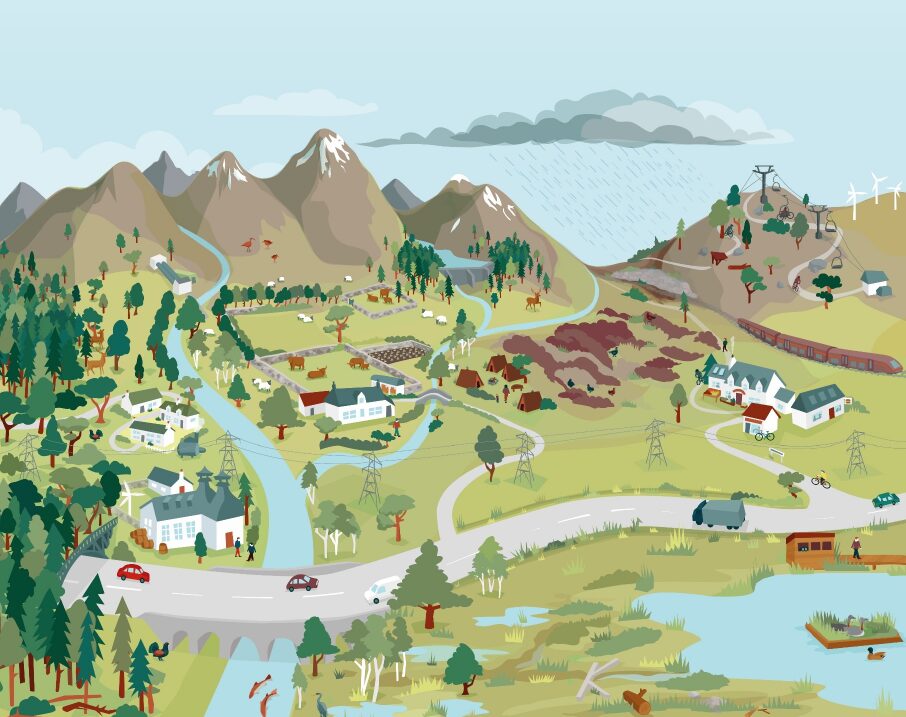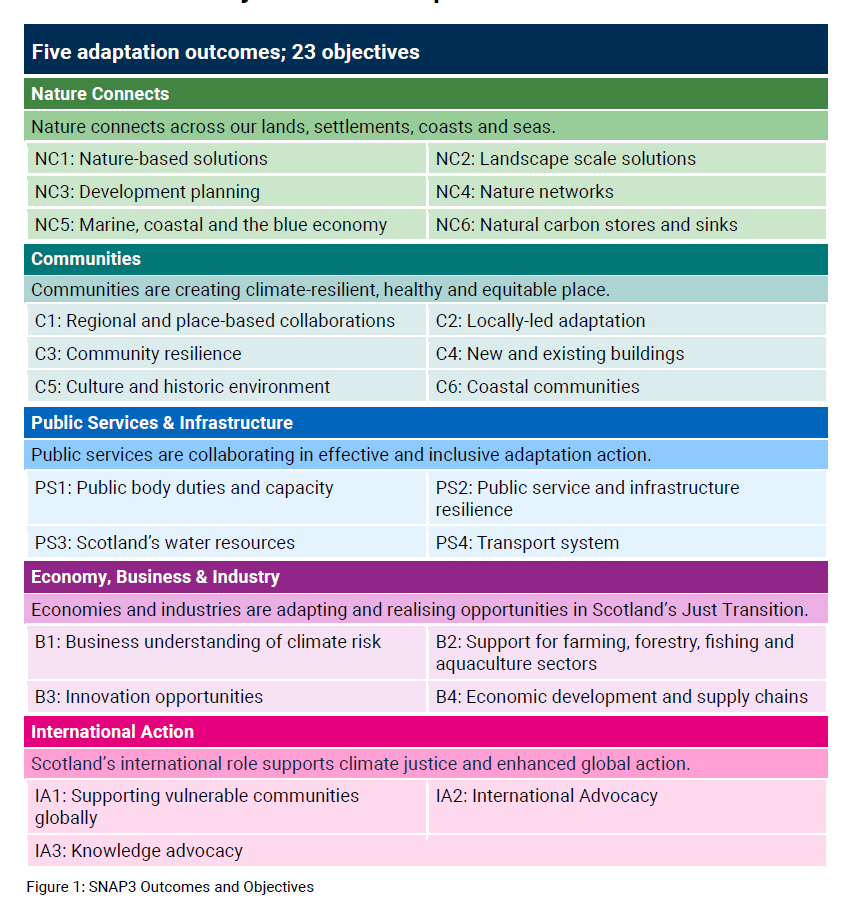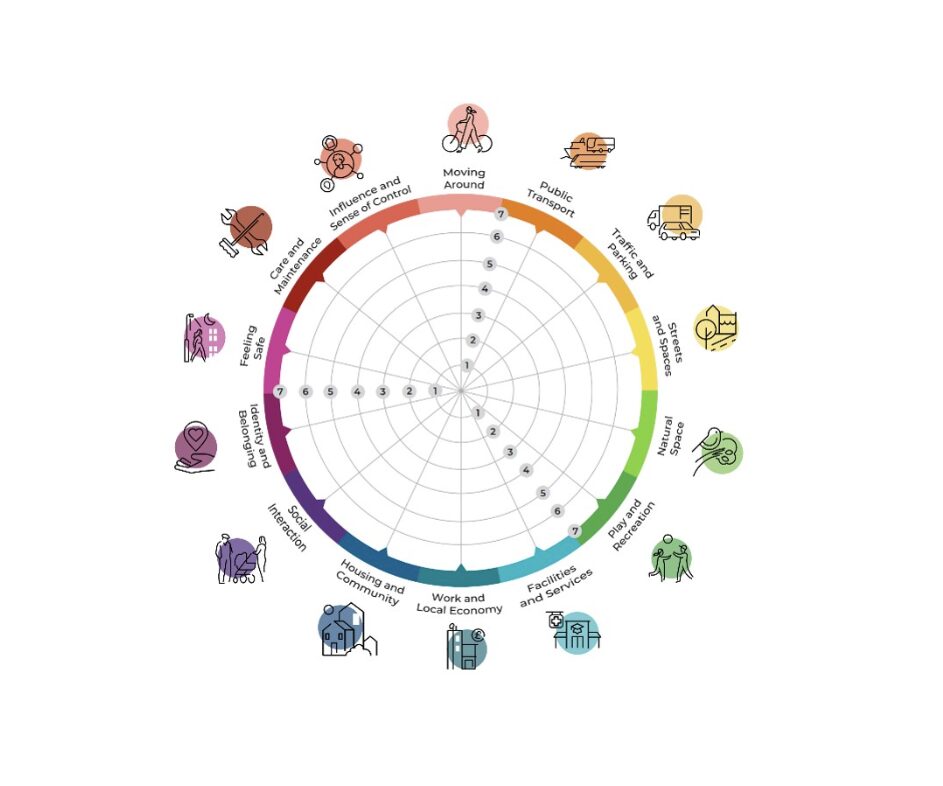Scottish National Adaptation Plan 2024 – 2029. Actions today, for a climate resilient future

This article is an abridged version of the original text, which can be downloaded from the right-hand column. Please access the original text for more detail, research purposes, full references, or to quote text.
Summary
The Scottish National Adaptation Plan 2024-2029 (SNAP3) has been in development since the third UK Climate Change Risk Assessment (UKCCRA3) was formally adopted in January 2022, setting out 61 risks and opportunities faced by all four UK nations. It responds to independent assessment of the risks facing Scotland carried out by the Climate Change Committee – the UK’s independent statutory advisors. It also responds to the feedback received through consultation on the draft plan which we published in January 2024. The original report plus an easy read version and a children’s version are available to download.
Climate change means that Scotland will be wetter in winters, drier in summers, sea level rise will continue, and the weather will become more variable and unpredictable. Extreme weather events, and the cascading impacts of climate change, are putting more pressure than ever before on lives and livelihoods.
Over the next five years, this Adaptation Plan commits to delivering over 200 policies and actions, including:
- Ensuring all parts of Scotland are building climate resilience though regional partnerships, local action and climate-resilient economies.
- Improving flood warnings for businesses and communities across Scotland, and building rainwater networks in urban areas to manage flash flooding.
- Encouraging behaviour change to help households and communities cope with both too much and too little water.
- Strengthening the new national network of Climate Action Hubs and ensuring that the Hubs are supporting vulnerable communities to adapt.
- Shifting 50% of agricultural funding to be conditional on delivering for climate and nature, including climate adaptation.
- Increasing Scotland’s railway resilience through investing approximately £400 million over the next five years, with multiple benefits for passengers.
Vision for a well-adapted Scotland
In 2024, the Scottish Government proposed that building Scotland’s resilience to climate change becomes a national outcome of Scotland’s National Performance Framework. The next five years will be critical to setting the country on the right path. The longer term vision, in line with the Adaptation Plan’s five outcomes, illustrates a Scotland where:
- Nature connects across Scotland’s land, settlements, coasts and seas – Scotland’s lands, seas, and settlements form connected natural networks that support biodiversity, protect against extreme weather, and enhance health and wellbeing. Adaptation strengthens these connections and makes places more fulfilling.
- Communities are creating climate-resilient, healthy and equitable places – People are creating resilient, healthy, and fair places, with safer buildings, valued knowledge, and culture supporting adaptation, even as coasts and climates change.
- Public services are collaborating in effective and inclusive adaptation action – As the climate changes, people’s wellbeing is supported by safe and resilient transport, water and other essential infrastructure. Adaptation has created a Scotland where climate actions with multiple benefits for health, wellbeing and equity are delivered, and collaborating on shared challenges is easier.
- Economies and industries are adapting and realising opportunities in Scotland’s Just Transition – Industries and livelihoods are adapting through a just transition, securing supply chains, sustaining rural and island communities, and fostering innovation in a wellbeing economy.
- Scotland’s international role supports climate justice and enhanced global action on adaptation – Scotland supports global climate justice, working with the Global South to strengthen resilience, halt nature loss, and advance cooperation to keep warming below 2°C.
Supporting all of Scotland’s priorities
Without adaptation, Scotland’s aspirations for economic success, poverty reduction, nature and high-quality public services will be undermined by the effects of climate change. The positive result of adaptation is that actions to address climate impacts can deliver multiple co-benefits for health, wellbeing, equity, economic growth, jobs and biodiversity. Without making changes in the daily activities of government, businesses and citizens and without the appropriate skills and finance, Scotland will be unable to build resilience to climate change in a way that is fair and equitable. Figure 3 below outlines the particularly important enabling factors for effective adaptation action.

The five adaptation outcomes
To build Scotland’s resilience to climate change and meet the long term adaptation outcomes, the Adaptation Plan’s 23 objectives set out priorities for action over the next five years – as shown below, in Figure 1. The associated data tool helps users navigate the Adaptation Plan, understand what climate risks are being addressed, and map the cross-cutting nature of adaptation policies. Each objective has an owner (or owners) with lead responsibility to drive delivery and accountability.

Suggested Citation
Scottish Government. Scottish National Adaptation Plan 2024–2029, page 6. Edinburgh: Scottish Government, September 25, 2024. https://www.gov.scot/publications/scottish-national-adaptation-plan-2024-2029-2/pages/6/





Comments
There is no content